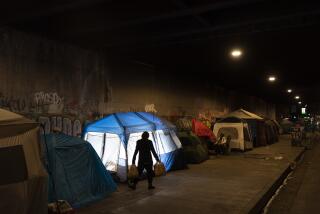Harlem Lost and Found : STILL LIFE IN HARLEM.<i> By Eddy L. Harris</i> .<i> Henry Holt & Co.: 276 pp., $20</i>
- Share via
Eddy L. Harris, an itinerant writer and observer, is not the first young African American to have been drawn “home” to Harlem, seeking to recapture the spirit of its glamorous past or desiring to forge within that community a strong sense of racial identity. Because of the enduring, at times deceptive, allure of Harlem, he will not be the last to be so drawn.
Nor is the nostalgia felt only by those who were not yet born when, from the 1920s to the mid-’30s, Harlem was the “Negro Capital” of the world, the black Paris of America. Visiting a Chicago tenement, Harris hears from an aging black woman: “If I ever get the chance to travel, and if I ever get to New York, the first thing I want to do is to get to Harlem.” “To do what?” he asks Olivia Maxwell. “Just to be there,” she says. What she knows about Harlem are the romantic things she saw in the movies, read in newspapers and magazines or heard from people who had lived there.
Harris understands, for he himself is on his way back to the Harlem of his imagination: “a black place, a magic place, a place full of wonderful history.” He further associates his “homeward” migration with the trends of an older time: “The high and the mighty, the lowly and disregarded; the leaders and the followers; artists and intellectuals--coming home to find peace, coming to gain in Harlem a sense of self and a new way of defining oneself, blackness, black culture, black consciousness.”
At that point in his life and wanderings, Harris was particularly vulnerable to the seductive call of Harlem. After spending a brief part of his boyhood there, he had grown up and gone to live in Europe: London and Yorkshire, Paris and the south of France. Coming back to America, he had lived in interracial neighborhoods but was left with a feeling of racial and cultural ambivalence. Only by returning to Harlem could he hope to find an answer--for Harlem “is ours: and mine,” a “metaphor of Black America.”
As a writer, Harris was inspired, to a degree, by a journey the young poet Langston Hughes, a Kansan, had made to the black Mecca--just before the extraordinary artistic and cultural explosion that placed Harlem on the national and international map. Hughes arrived there in 1921, aspiring to join the nascent New Negro Literary Renaissance, to develop himself and his talent among the poets and prose writers who had preceded him there. Others were to follow, from disparate points in America and the Caribbean. Harlem, with its attractive town houses and spacious apartment buildings, became a miraculous refuge for blacks of all classes. And the pool of their energies in that liberating environment helped create the flowering in arts and letters that took place in the 1920s. That was the Harlem into which Hughes arrived. After emerging from the subway at Lenox Avenue and 135th Street--then the crossroads of the black world--he dropped his bags, inhaled the air of a stylish and self-confident community and felt happier than he had felt in a long time.
On Harris’ first day back in Harlem, he “came up from the subway into the bright light of day” and “felt a little of what Langston Hughes must have felt when he arrived. . . . It was a bright September afternoon that greeted him. And he was happy and thrilled to be here, so was I.”
But the Harlem to which he had come was not the one yet untarnished that Hughes first saw. On the stairs up from the subway, Harris stepped over a sleeping man, probably the worse for drink; at the top, an old man barred his path and begged for spare change; the subway entrance smelled of stale urine. In his excitement at being back, he did not recognize those as cautionary omens. He cared only that he had “come home again,” for “there was no place on Earth I would rather be.” Moreover, he would soon be reassured by the vigor and bustle of 125th Street, signs to him that “there was still vibrant life in Harlem.”
That vibrancy began fading in his imagination as Harlem gradually revealed to him a number of its less attractive sides. He was frequently awakened by terrible shrieks in the night. He had encounters with street toughs who threatened, coldbloodedly, to “pop” him, or gun him down. He was appalled by the sight of run-down apartment buildings, with no trash cans in front of them, and by the spectacle of tenants stomping rats to death. The sidewalks were “an obstacle course of garbage” and dog droppings. Rubbish piled “on just about every street,” luring rats out “into the open to forage for food.” Almost all the streets reeked “of ruin, poverty and despair.” They were “paved no longer with gold” but with filth. In his growing disillusionment, he laments, “Harlem might very well be the darkest, dirtiest and most dangerous place on the face of the Earth”--by no means the old “paradise” that had seduced his imagination.
Awakened by one of the ear-splitting screams in the night, Harris looked through a window of his apartment and saw a man bashing a woman against a wall. The man “was exhibiting his power, pounding out of her the respect the world had pounded out of him, demanding with each well-placed blow the same submission from her that had been demanded of him.” That scene marked the beginning of the end of Harris’ two-year stay in Harlem. In that “moment of clarity,” he had had enough; he wanted no more.
Only a few seconds earlier he had been thinking “what a beautiful place Harlem must have been at one time and wondering where the beauty went.” The past was indeed “a dangerous place to visit.” If a little beauty remained, it was not enough to counterbalance “what has become so lifeless, so tired, and so ugly.” There was “a barrenness” to whatever life there still was in the former black metropolis of the world.
Harris’ book is an impressively written work of urban memoir and meditation, a distinguished example of its kind. Yet not all Harlemites would concur with the severity of its ultimate judgments or would consider its findings to be representative of Harlem as a whole. Those judgments and findings reflect generalization, and generalization can be as faulty as the author’s imagination was when he first returned to the Harlem of his fantasy. By focusing on signs of sociological rot and proletarian predicament, Harris presents a picture of today’s Harlem in which few members of its remaining middle class will recognize themselves. They will discern in it no serious account of their social and cultural experience, their libraries and museums and resilient churches from the past, the more appealing residential sectors of their community.
Though Harris recognizes a few of those sectors--the people still residing in once-fashionable row houses and “elegant” apartment buildings--he does so swiftly and dismissively, with a contempt he cannot quite conceal. Yet those people, who deserve to be celebrated, are survivors of the wonderful cultural history that attracted Harris back to Harlem. How, in any case, were they supposed to live? As an exemplary middle class, they surely could not be expected to merge their lifestyles with a culture of sociological failure and decay. Weren’t they redeeming cases in a spreading desert of violence, misery and despair? Weren’t they legitimate components of what remained affirmative and hopeful in the life of Harlem?
Notable among the proud remnants of Harlem’s middle class are the successful young professionals, some with careers on Wall Street, who began resettling there more than a decade ago. They have been acquiring and renovating old town houses, restoring them to the gentrified status from which they descended. In view of the houses and blocks these new professionals occupy, the projects in resurrection they have successfully undertaken, they cannot possibly endorse near-sweeping conclusions about Harlem’s filthiness, ugliness and barrenness. They would argue that Harris, in his negative and disillusioning discoveries, took insufficient notice of the precincts in which they have invested their savings and their faith--their optimistic commitment to the life and future of Harlem.


